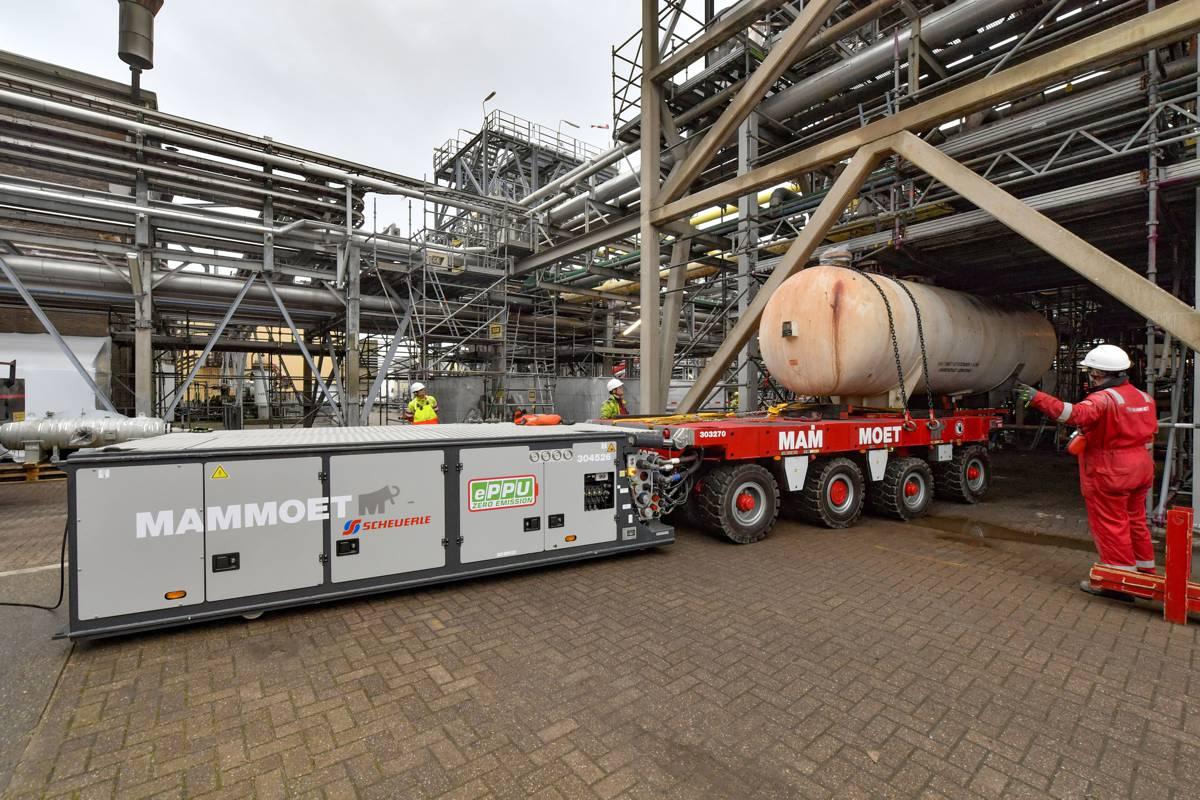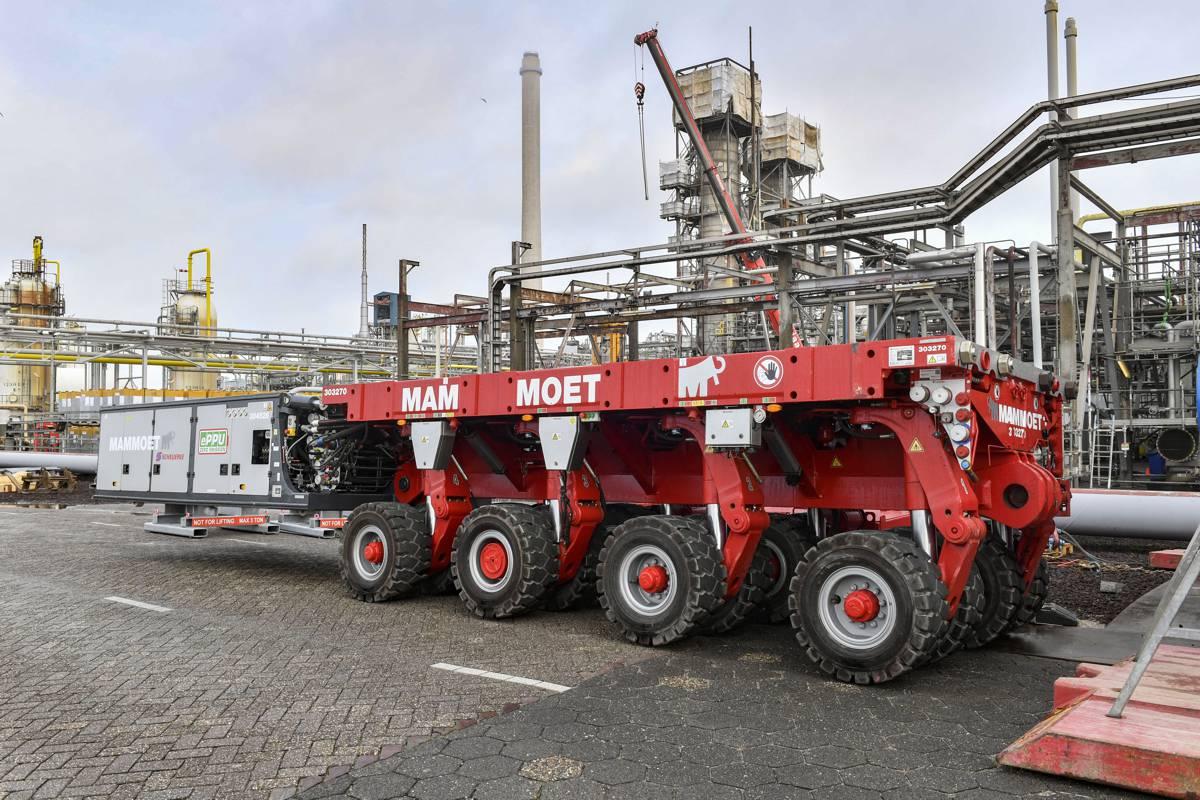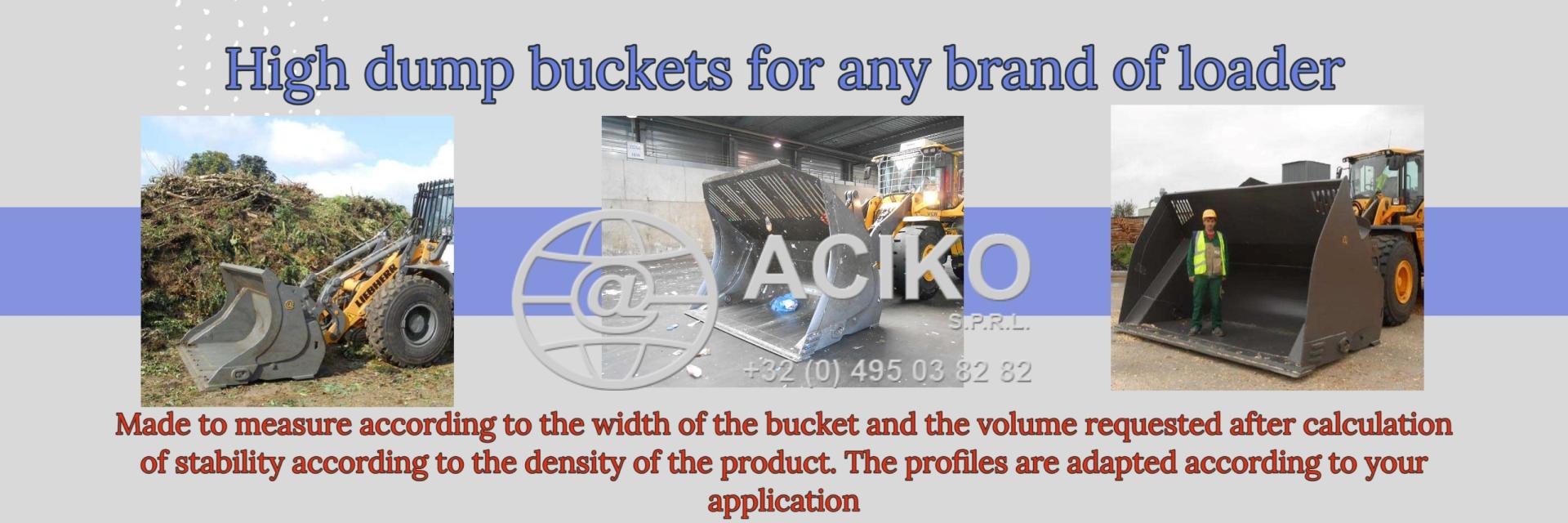Mammoet completes world’s first Electric Powered Heavy Transport
02/05/22-FR-English-NL-footer
Mammoet achève le premier transport lourd électrique au monde
 Mammoet a franchi une étape majeure dans le développement du levage et du transport durables de charges lourdes en entreprenant le remplacement d'un navire de production dans une usine chimique aux Pays-Bas utilisant de l'énergie purement électrique.
Mammoet a franchi une étape majeure dans le développement du levage et du transport durables de charges lourdes en entreprenant le remplacement d'un navire de production dans une usine chimique aux Pays-Bas utilisant de l'énergie purement électrique.
L'usine Shell produit des matières premières pour une gamme d'applications quotidiennes, notamment des équipements médicaux, des composants automobiles et des téléphones portables. Lorsqu'un navire de production clé devait être remplacé, le client était désireux de voir comment cela pouvait être fait avec le moins d'impact possible sur l'environnement.
À la recherche de moyens par lesquels les nouvelles technologies peuvent aider à réduire – et éventuellement à éradiquer – l'empreinte carbone des projets, Mammoet a exploré de nombreuses solutions possibles ces dernières années. L'un de ces objectifs a été un partenariat avec Scheuerle pour faire passer sa flotte SPMT du diesel à l'énergie renouvelable.
Alors que la technologie électrique n'est pas nouvelle pour les véhicules domestiques, la force pure que les SPMT doivent fournir pour déplacer des objets lourds a présenté des obstacles importants à la recherche d'une solution équivalente. Mais grâce à des recherches et à des tests approfondis, cela est maintenant devenu une réalité.
L'ePPU a été utilisé avec quatre lignes d'essieux de SPMT opérant dans une zone extrêmement étroite de l'usine existante, ce qui signifiait qu'il n'y avait que quelques mètres pour manœuvrer le navire existant et mettre le nouveau en place.
 En fait, l'espace était si limité que toutes les lignes SPMT ne pouvaient pas être positionnées sous le navire sortant, ce qui signifiait qu'il devait être fixé au-dessus des deux lignes d'essieux avant du SPMT, l'ePPU agissant comme un contrepoids pour équilibrer le navire tel qu'il était. transporté. Une grue a ensuite été utilisée pour retirer l'ancienne cuve et déposer sa remplaçante sur le SPMT dans la même position. Celui-ci a ensuite été remis en place, prêt à être installé et mis en service.
En fait, l'espace était si limité que toutes les lignes SPMT ne pouvaient pas être positionnées sous le navire sortant, ce qui signifiait qu'il devait être fixé au-dessus des deux lignes d'essieux avant du SPMT, l'ePPU agissant comme un contrepoids pour équilibrer le navire tel qu'il était. transporté. Une grue a ensuite été utilisée pour retirer l'ancienne cuve et déposer sa remplaçante sur le SPMT dans la même position. Celui-ci a ensuite été remis en place, prêt à être installé et mis en service.
L'utilisation de l'ePPU a apporté des avantages importants pour le projet. Ludo Mous, directeur des opérations chez Mammoet Europe, explique : « L'ePPU est une étape très importante dans la manière dont nous accompagnons nos clients dans leurs projets de décarbonisation. Mais dans ce cas, les avantages ne se limitaient pas seulement à une empreinte carbone plus faible. Le travail se déroulant dans une zone très confinée, nous aurions été très conscients des émissions générées par un PPU diesel typique et nous aurions dû gérer avec soin l'exposition des opérateurs à celle-ci. En utilisant un modèle électrique, nous avons complètement éliminé ce problème, tout en créant un environnement de travail beaucoup plus silencieux.
 L'application réussie de l'ePPU ici ne marque que le début d'un développement passionnant pour Mammoet et l'industrie au sens large. Bien qu'il reste encore du travail à faire pour s'assurer que l'énergie électrique est suffisante pour une utilisation dans des projets SPMT à plus grande échelle, la technologie a maintenant fait ses preuves et est prête à être déployée dans un plus large éventail de travaux à travers le monde.
L'application réussie de l'ePPU ici ne marque que le début d'un développement passionnant pour Mammoet et l'industrie au sens large. Bien qu'il reste encore du travail à faire pour s'assurer que l'énergie électrique est suffisante pour une utilisation dans des projets SPMT à plus grande échelle, la technologie a maintenant fait ses preuves et est prête à être déployée dans un plus large éventail de travaux à travers le monde.
Mous conclut : « Nous avons été extrêmement satisfaits que l'ePPU ait fonctionné comme prévu, offrant une solution à faible émission de carbone à notre client. Nous nous attendons à ce que la demande soit élevée, en particulier pour les projets qui recherchent des options plus durables ou pour lesquels les émissions de gaz d'échappement doivent être réduites au minimum pour des raisons de sécurité, comme les projets civils se déroulant dans des tunnels ou des travaux à l'intérieur d'installations nucléaires.
NJC.© Info Mammoet
----------------------------------------------------------------------------------------------------------------------
02/05/22-English
Mammoet completes world's first Electric Powered Heavy Transport
 Mammoet has achieved a major milestone in the development of sustainable heavy lifting and transport – undertaking the replacement of a production vessel at a chemical plant in the Netherlands using purely electric power.
Mammoet has achieved a major milestone in the development of sustainable heavy lifting and transport – undertaking the replacement of a production vessel at a chemical plant in the Netherlands using purely electric power.
The Shell facility produces feedstock for a range of everyday applications including medical equipment, car components and cellphones. When a key production vessel needed to be replaced, the customer was keen to look at how this could be done with the lowest possible environmental impact.
Seeking ways in which new technology can help to reduce – and eventually eradicate – the carbon footprint of projects, Mammoet has explored many possible solutions in recent years. One such focus has been a partnership with Scheuerle to transition its SPMT fleet from diesel to renewable energy.
Whilst electric technology is nothing new for domestic vehicles, the sheer force SPMTs are required to deliver in moving heavy items has presented significant barriers to finding an equivalent solution. But thanks to extensive research and testing this has now become a reality.
 The ePPU was used with four axle lines of SPMT operating in an extremely tight area of the existing plant, which meant that there were only a few meters in which to maneuver the existing vessel out and drive the new one into position.
The ePPU was used with four axle lines of SPMT operating in an extremely tight area of the existing plant, which meant that there were only a few meters in which to maneuver the existing vessel out and drive the new one into position.
In fact, space was so limited that not all SPMT lines could be positioned beneath the outgoing vessel, meaning that it needed to be secured above the front two axle lines of SPMT, with the ePPU acting as a counterweight to balance the vessel as it was transported. A crane was then used to remove the old vessel and lower its replacement onto the SPMT in the same position. This was then moved back into place ready to be installed and commissioned.
Using the ePPU delivered important benefits for the project. Ludo Mous, Operations Director at Mammoet Europe, explains: “The ePPU is a really important step in how we support our customers with decarbonizing projects. But in this case, the benefits were not limited only to a lower carbon footprint. With work taking place in a highly confined area, we would have been highly aware of the emissions generated by a typical diesel PPU, and would need to carefully manage operatives’ exposure to it. By using an electric model, we removed this issue completely, whilst also creating a much quieter working environment.”
 The successful application of the ePPU here signals just the start of an exciting development for Mammoet and the wider industry. Although there is still work to be done to ensure electric power is sufficient for use in larger scale SPMT projects, the technology is now proven in use and ready to be rolled out across a broader range of work around the world.
The successful application of the ePPU here signals just the start of an exciting development for Mammoet and the wider industry. Although there is still work to be done to ensure electric power is sufficient for use in larger scale SPMT projects, the technology is now proven in use and ready to be rolled out across a broader range of work around the world.
Mous concludes: “We were extremely pleased that the ePPU performed as we expected, delivering a low-carbon solution for our customer. We expect demand for it to be high, in particular for projects that are looking for more sustainable options or where exhaust emissions must be kept to a minimum for safety reasons, such as civil projects taking place within tunnels or work inside nuclear facilities.”
NJC.© info Mammoet
---------------------------------------------------------------------------------------------------------------
02/05/22-NL
Mammoet voltooit 's werelds eerste elektrisch aangedreven zwaar transport
 Mammoet heeft een belangrijke mijlpaal bereikt in de ontwikkeling van duurzaam zwaar hijswerk en transport: de vervanging van een productieschip in een chemische fabriek in Nederland op puur elektrische stroom.
Mammoet heeft een belangrijke mijlpaal bereikt in de ontwikkeling van duurzaam zwaar hijswerk en transport: de vervanging van een productieschip in een chemische fabriek in Nederland op puur elektrische stroom.
De Shell-faciliteit produceert grondstoffen voor een reeks alledaagse toepassingen, waaronder medische apparatuur, auto-onderdelen en mobiele telefoons. Toen een belangrijk productievat aan vervanging toe was, wilde de klant graag kijken hoe dit kon met een zo laag mogelijke impact op het milieu.
Op zoek naar manieren waarop nieuwe technologie kan helpen om de ecologische voetafdruk van projecten te verkleinen – en uiteindelijk uit te bannen – heeft Mammoet de afgelopen jaren veel mogelijke oplossingen onderzocht. Een van die aandachtspunten was een samenwerking met Scheuerle om zijn SPMT-vloot over te zetten van diesel naar hernieuwbare energie.
Hoewel elektrische technologie niets nieuws is voor huishoudelijke voertuigen, vormt de enorme kracht die SPMT's moeten leveren bij het verplaatsen van zware voorwerpen aanzienlijke belemmeringen voor het vinden van een gelijkwaardige oplossing. Maar dankzij uitgebreid onderzoek en testen is dit nu werkelijkheid geworden.
De ePPU werd gebruikt met vier aslijnen van SPMT die in een extreem krap gebied van de bestaande fabriek werkten, wat betekende dat er maar een paar meter was om het bestaande vaartuig naar buiten te manoeuvreren en het nieuwe op zijn plaats te drijven.
 In feite was de ruimte zo beperkt dat niet alle SPMT-lijnen onder het uitgaande schip konden worden geplaatst, wat betekende dat het boven de voorste twee aslijnen van SPMT moest worden vastgezet, waarbij de ePPU als tegengewicht fungeerde om het schip te balanceren zoals het was vervoerd. Vervolgens werd een kraan gebruikt om het oude schip te verwijderen en het vervangingsvaartuig in dezelfde positie op de SPMT neer te laten. Dit werd vervolgens terug op zijn plaats gezet, klaar om te worden geïnstalleerd en in gebruik genomen.
In feite was de ruimte zo beperkt dat niet alle SPMT-lijnen onder het uitgaande schip konden worden geplaatst, wat betekende dat het boven de voorste twee aslijnen van SPMT moest worden vastgezet, waarbij de ePPU als tegengewicht fungeerde om het schip te balanceren zoals het was vervoerd. Vervolgens werd een kraan gebruikt om het oude schip te verwijderen en het vervangingsvaartuig in dezelfde positie op de SPMT neer te laten. Dit werd vervolgens terug op zijn plaats gezet, klaar om te worden geïnstalleerd en in gebruik genomen.
Het gebruik van de ePPU leverde belangrijke voordelen op voor het project. Ludo Mous, Operations Director bij Mammoet Europe, legt uit: “De ePPU is een heel belangrijke stap in de manier waarop we onze klanten ondersteunen bij het koolstofvrij maken van projecten. Maar in dit geval waren de voordelen niet alleen beperkt tot een lagere CO2-voetafdruk. Met het werk dat plaatsvindt in een zeer beperkte ruimte, zouden we ons zeer bewust zijn geweest van de emissies die worden gegenereerd door een typische diesel-PPU, en zouden we de blootstelling van medewerkers eraan zorgvuldig moeten beheren. Door een elektrisch model te gebruiken, hebben we dit probleem volledig weggenomen, terwijl we ook een veel stillere werkomgeving hebben gecreëerd.”
 De succesvolle toepassing van de ePPU hier markeert slechts het begin van een opwindende ontwikkeling voor Mammoet en de bredere industrie. Hoewel er nog werk aan de winkel is om ervoor te zorgen dat elektrische stroom voldoende is voor gebruik in grootschalige SPMT-projecten, is de technologie nu bewezen in gebruik en klaar om te worden uitgerold over een breder scala aan werk over de hele wereld.
De succesvolle toepassing van de ePPU hier markeert slechts het begin van een opwindende ontwikkeling voor Mammoet en de bredere industrie. Hoewel er nog werk aan de winkel is om ervoor te zorgen dat elektrische stroom voldoende is voor gebruik in grootschalige SPMT-projecten, is de technologie nu bewezen in gebruik en klaar om te worden uitgerold over een breder scala aan werk over de hele wereld.
Mous concludeert: “We waren zeer verheugd dat de ePPU presteerde zoals we hadden verwacht en een koolstofarme oplossing voor onze klant opleverde. We verwachten dat de vraag ernaar groot zal zijn, met name voor projecten die op zoek zijn naar duurzamere opties of waar de uitstoot van uitlaatgassen om veiligheidsredenen tot een minimum moet worden beperkt, zoals civiele projecten die plaatsvinden in tunnels of werkzaamheden in nucleaire faciliteiten.”
NJC.© Info Mammoet
--------------------------------------------------------------------------------------------------------------------
















